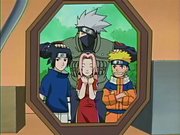
NARUTO
Plot Overview

Twelve years before the events at the focus of the series, the nine-tailed demon fox attacked konohagakure. It was a powerful demon indeed; a single swing of one of its nine tails would raise tsunamis and flatten mountains. It raised chaos and slaughtered many people, until the leader of the Leaf Village –- the Fourth Hokage –- defeated it by sacrificing his own life to seal the demon inside a newly-born child, whose origins are as yet unknown. That child's name was Naruto Uzumaki. The Fourth Hokage was celebrated as a hero for sealing the demon fox away. He wanted Naruto to be respected in a similar light by being the containment vessel for the demon fox. The village he grew up in, however, mostly shunned Naruto; they regarded him as if he were the demon fox itself and mistreated him throughout most of his childhood. A decree made by The Third Hokage made it so that the other villagers were forbidden to mention the event to anyone, even to their own children. However, this did not stop them from treating Naruto like an outcast. Although their children did not specifically know why their parents treated Naruto the way they did, they learned through example to despise the boy. As a result, Naruto grew up as an in a lonesome atmosphere without friends, family, or acknowledgement. He could not force people to befriend him, so he sought acknowledgement and attention the only way he knew – through pranks and mischief.
However, that soon changed after Naruto graduated from the Ninja Academy by using his Multiple Shadow Clone Technique to save his teacher, Iruka Umino, from the renegade ninja. That encounter gave Naruto two insights: that he was the container of the Kyūbi, and that there was someone (Iruka and the Third Hokage, initially) who actually cared about him. His graduation opened a gateway to the events and people that would change and define his world and his way of the ninja for the rest of his life.
Naruto maintains a balance between drama and comedy, with plenty of action interspersed. It follows Naruto and his friends' personal growth and development as ninja, and emphasizes their interactions with each other and the influence of their backgrounds on their personalities. Naruto finds two friends and comrades in Sasuke Uchiha and Sakura Haruno, two fellow young ninja who are assigned with him to form a three-person team under a very experienced sensei named Kakashi Hatake. Naruto also confides in other characters as well that he has met through the Chcnin Exam. They learn new abilities, get to know each other and other villagers better, and experience a coming-of-age journey as Naruto dreams of becoming the Hokage of the Leaf Village.
Naruto places strong emphasis on character development. Almost all outcomes are a result of decisions, character, and personality; very few things happen just because of chance. At first, emphasis is placed on Naruto, Sasuke, and Sakura, who are the members of Team 7. However, other characters are developed, such as Kakashi, Guy, and Jiraiya, as well as Naruto's peers, such as the other Genin teams.
Several major villains came into play as well, the first being Zabuza Momochi a missing-nin from the Hidden Mist Village, and his partner Haku Later, in the Chūnin Exam arc, Orochimaru is introduced as an S-Class missing-nin at the top of the Leaf Village's most wanted list. Also, a mysterious organization called Akatsuki (which consists of 10 S-Rank criminals) begins to pursue Naruto for the demon inside him.
|